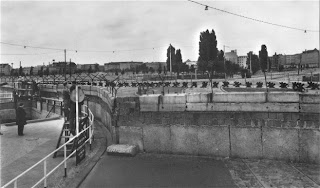Saturday, 27 February 2010
Blogging again
Thursday, 2 October 2008
Time Traveler's Wife



Jules Vernacular
Wednesday, 1 October 2008
Three Trees
Pictures



Checkpoint Charlie Museum

A stark contrast to the Warsaw Uprising Museum mentioned in my previous post, is the Checkpoint Charlie Museum in Berlin.
Warsaw Uprising Museum




From a young age, I've been dragged around many a war museum due to my Dad's fascination with anything WW2. However, I found the Warsaw Uprising Museum a refreshing change. Opened in 2004, it is considered the most modern museum in Poland.
Sony Centre - Potsdamer Platz, Berlin





After WW2, Potsdamer Platz was left destroyed after originally being a bustling city centre, later becoming a wasteland - with only the Berlin wall as a landmark.
Stalin's 'Palace of Culture and Science'

A 'gift' from the Soviet Union to the people of Poland. The architecture is closely related to several similar skyscrapers build in the Soviet Union in the same era (such as the Moscow Kremlin), however the main architect incorporated Polish details into the project by traveling around Poland and noting its architecture - the monumental walls are headed with pieces of masonry copied from renaissance houses and palaces of Krakow and Zamosc.
Reichstag - Berlin




The Reichstag in Berlin was constucted to house the Reichstag (the first parliament of the German Empire). It housed the Reichstag until 1933, until it was severly damanged in a fire. The Reichstag became the seat of the German parliament again in 1999 after a reconstruction by the British architect Norman Foster.
Berlin World Time Clock


Located in Alexanderplatz in Berlin is their World Time Clock, erected in 1969 as part of the square's redevelopment and has become a popular meeting point. It a continually rotates showing the time throughout the globe.
Weighing 16 tonnes and 10 metres tall, it features a revolving cylinder with the world's 24 time zones bearing the names of major cities in each zone. The mechanism constructed in a way which enables the current time in each zone to be read.
The clock looks quite dated now, but I loved the textures on the metal and the way that the type has been cut out.
Calvin Klein shop front

Not the best photo, but I must admit I felt awkward taking a photo. This is the Calvin Klein store in the Trafford Centre.
Wednesday, 10 September 2008
Advertising Concept Book: Think Now, Design Later
 A book I've read over the summer - practical advice on a variety of topics, including putting together your porfolio, as well as a wide account of the best advertising campaigns over the past 20 or so years. Interestingly, all the illustrations are pencil-drawn, to allow the reader to focus on the concepts themselves.
A book I've read over the summer - practical advice on a variety of topics, including putting together your porfolio, as well as a wide account of the best advertising campaigns over the past 20 or so years. Interestingly, all the illustrations are pencil-drawn, to allow the reader to focus on the concepts themselves.
Friday, 29 August 2008
Conor Oberst solo album
 So I only half listened to this album once (in the car, on the way) before I saw Conor Oberst in Manchester this week, and so I (like everyone else there) was hoping he'd play something... anything off 'I'm Wide Awake, It's Morning' (he even seemed to tease us with hammer-ons sounding very much like 'First Day...').. and of course he didn't play anything. But he did properly introduce me to this superb album, played extremely tightly with his band. Upbeat tracks such as "Souled Out!!!" and "Get-Well-Cards" sit nicely within the more Bright Eyes formulated eerie songs such as the magnificent "Money Lenders" and "Canaveral".
So I only half listened to this album once (in the car, on the way) before I saw Conor Oberst in Manchester this week, and so I (like everyone else there) was hoping he'd play something... anything off 'I'm Wide Awake, It's Morning' (he even seemed to tease us with hammer-ons sounding very much like 'First Day...').. and of course he didn't play anything. But he did properly introduce me to this superb album, played extremely tightly with his band. Upbeat tracks such as "Souled Out!!!" and "Get-Well-Cards" sit nicely within the more Bright Eyes formulated eerie songs such as the magnificent "Money Lenders" and "Canaveral".Tuesday, 19 August 2008
Bike racks


Saturday, 16 August 2008
Hann would be proud..
"His work breaks the process of pattern construction into two steps. First, the designer chooses a tiling of the plane. Then the software places small geometric motifs in every tile, a process governed by a small set of parameters under the designer’s control. The motifs link together to form a finished design. The computer handles the tedium of precise, repetitive drawing, thus freeing the human designer to explore the space of star patterns quickly and enjoyably."
If only we had it for Design Theory assignments...

Star Wars - Clone Wars animated





Friday, 15 August 2008
Siggraph 08


Everyone makes mistakes..!
But the skyline image used was actually one of Birmingham, Alabama, USA...
It took a resident who received the pamphlet to realise that the image was wrong. Initially, the council claimed no mistake had been made and the "generic skyline [was] intended to symbolise an urban area".. they later admitted they had made a mistake. Ha!

Monday, 11 August 2008
LA Architecture


Sunday, 10 August 2008
Upper Playground
237
I watched Princess Mononokee (another masterpiece by Studio Ghibli) tonight, which is well worth watching just for these little characters.

I googled them to then find out about 237, an urban art project started in Spain, who have left these guys around their streets.













